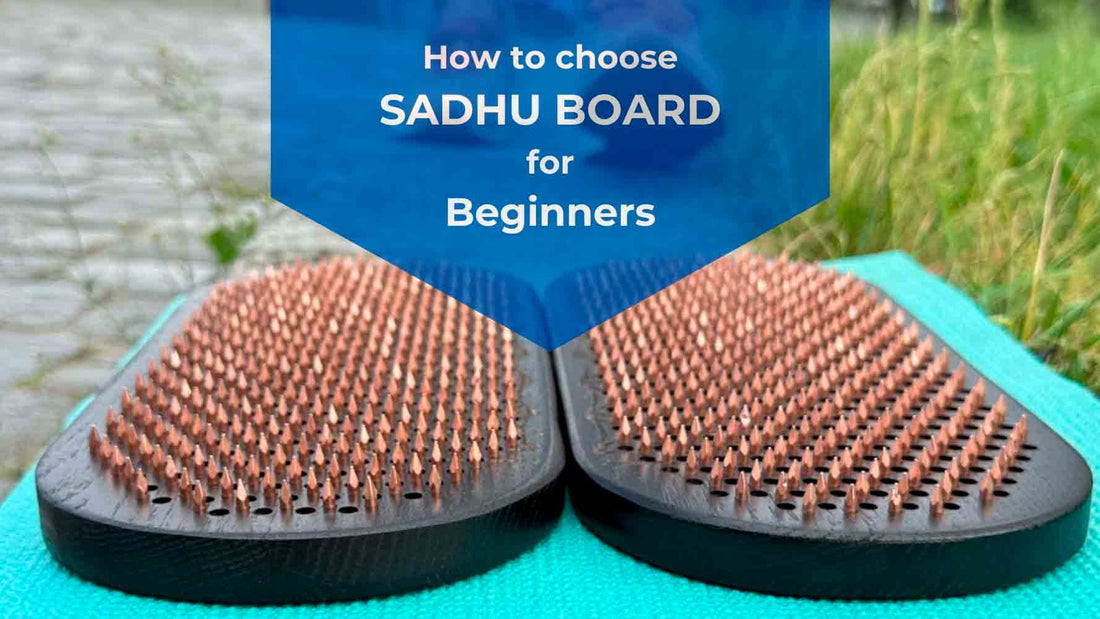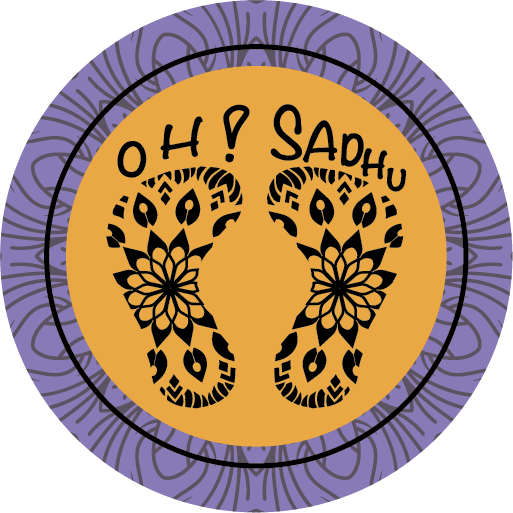
Guide to Choosing the Perfect Sadhu Board for Beginners
Share
Sadhu board is something new, unusual, and even mystical for those who are just beginning their journey into the practice of standing on nails. Many people discover it with surprise, others with fascination — but almost everyone agrees that this practice contains something deep and transformative. If you’ve decided to give it a try, it’s important to choose your first Sadhu board wisely. After all, your comfort, first impressions, and the desire to continue the practice largely depend on this first step.
In this article, we will go over the key factors that will help you choose the right Sadhu board for your needs — including the spacing between the nails, the materials used, board type, design, and other essential details.
Table of Contents
- Distance Between Nails
- Base Material of the Sadhu Board
- Nail Material
- Static or Dynamic Sadhu Boards
- Design, Shape, and Length of Sadhu Boards
- Budget, Set, Shipping, Availability
Distance Between Nails

It’s easy to understand: the smaller the distance between the nails, the easier it is to stand on a Sadhu board. The nail step in Sadhu boards starts at 8mm (0.31in). This spacing allows beginners to stay within their comfort zone. If your goal with nail standing is purely acupressure, then the 8mm step is a good place to start.
Yes, it may seem logical to begin with the easiest option and gradually get used to the pain. For trying it the first time, 8mm will suit most people – without sharp pain, you’ll get a light stimulating effect. It’s like a trial version of the Sadhu board – without the full features.
But a Sadhu board offers much more.
Sadhu board 10mm (0.39in) nail step is the most popular for a reason. It’s the perfect choice to dive deep into practice, step out of your comfort zone, and truly challenge yourself.
If you’re buying a Sadhu board as a gift or for yourself with the intention to fully benefit from the practice, confidently choose the 10mm distance. These Sadhu boards are usually in stock, so there’s no need to wait for production.
Your first practice might not last more than a minute – and that’s already a great achievement. But that’s the essence of nail standing: developing yourself, learning to feel and control your state. You might go through stages like using socks or leaning for support – and that’s perfectly okay. But if you aim to progress – to release physical and emotional blocks, to understand and accept your state – you’ll break through this barrier and eventually stand barefoot for as long as needed. Once you pass the 5-minute mark, it becomes a pleasure. You’ll know what we mean when you get there :)
12mm and 15mm are for true enthusiasts and advanced Sadhu board practitioners – those who never stop growing and seek new peaks of self-discovery.
Base Material of Sadhu Boards

Modern Sadhu boards can be made from anything that holds nails – natural wood (like in our Oh! Sadhu boards), plywood, EVA foam, epoxy resin, and more. Each material has its pros and cons. Here’s why we chose natural wood, despite its complexity: we believe the best Sadhu board experience starts with the finest, most natural materials.
The practice begins the moment you hold your Sadhu board. Natural wood gives you an organic tactile experience, carries a natural scent and energy, and every board is unique in its grain and feel. You’re holding a piece of Mother Earth – calming and inspiring. Plywood or foam can never offer that.
Also, wood is heavier – which might seem like a downside for portability, but it’s a plus during nail standing. A heavier Sadhu board stays firmly on the floor. Always place your Sadhu board on a yoga mat or soft, non-slip surface for safety. Importantly, when ending your practice, nails often stick slightly to your feet. A lightweight board may lift with your foot, preventing you from stepping off safely – which can lead to injury.
Ask yourself: would you rather drink tea from fine porcelain or a plastic/paper cup? That’s the difference between wood and synthetic Sadhu boards.
Nail Material
Typically, Sadhu boards use copper, galvanized steel, or bamboo nails.
From our experience and hundreds of our students, copper nails are the best. They feel warmer, more pleasant. Copper is revered in many spiritual traditions as a symbol of harmony, balancing the material and spiritual, and promoting inner peace. It’s also an excellent conductor, believed to purify and protect from negative energy. Copper has antibacterial properties and never rusts.
Galvanized nails are functional but quality varies. They may differ in length, have burrs, be overly sharp, or poorly galvanized. Our nails are custom-made to strict standards, specifically for Sadhu board practice – making our Sadhu boards safe, comfortable, and reliable.
Bamboo nails are ideal for travelers. Their main advantage is lightness. However, remember that lightweight Sadhu boards come with the downsides mentioned earlier. Bamboo nails are more expensive than copper because each nail is handmade from bamboo sticks – and each board contains around 500 nails.
Also, consider the nail arrangement pattern on the Sadhu board. The best layout is the Flower of Life (hexagon). In this pattern, each nail is surrounded by six others at equal distances, ensuring even pressure on your feet. Diamond or square patterns offer only four evenly spaced neighboring nails – the rest are further apart, leading to uneven pressure distribution.
Proving Quality: A Balloon Test for Our Sadhu Nail Board
Watch this quick video where an ordinary balloon rolls over the nails of a Sadhu board — and stays intact. This simple demonstration shows that the nails are perfectly aligned, smooth, and safe even for the most delicate surfaces.
Static vs. Dynamic Sadhu Boards
Static Sadhu boards have fixed nails – just like traditional boards used by ancient yogis. For effective, regular nail standing practice, these are the go-to choice. High-quality static Sadhu boards last for years and always perform as intended – because they’re simple and reliable.
Dynamic Sadhu boards are more complex. The nails can move vertically with a slight amplitude, thanks to elastic padding and slightly larger holes. The idea is that nails adjust to your feet and reduce pressure/pain. However, in practice, this doesn’t always happen. The effectiveness depends on factors like body weight, foot size/shape, and the density of the EVA foam layer. Dynamic Sadhu boards are also more expensive and less durable – the padding may deform or tear over time. Creating a high-quality dynamic board requires precise materials and expertise. Their price starts around $130.
Design, Shape, and Size of Sadhu Boards
Design – Choose a Sadhu board that resonates with you spiritually and emotionally. Select materials, colors, and engravings that inspire you and align with your practice. Want something unique? We can create a custom Sadhu board just for you.
Shape – Any shape works. Rectangles and ovals are most common. We also make Sadhu boards shaped like wings or feet – ergonomic and safe for stepping off.
Size – Standard Sadhu boards are 30–32cm (11.8–12.6in) long, perfect for foot sizes EU 43–45 (US 10–11.5). The working surface is about 27–29cm. If your feet are size EU 46+ (US 12+), choose a board 34cm+ in length.
Budget, Completeness, Delivery & Availability

Budget – Sadhu boards aren’t cheap. It may seem like it’s “just wood and nails,” but crafting a quality Sadhu board requires proper tools, skills, and safe construction. If a board is too cheap, you should question its quality.
We offer a minimalist design to reduce cost while still using premium materials – ideal for those trying Sadhu boards for the first time or who want a more affordable option. Others go straight for a high-end Sadhu board that brings complete satisfaction. We offer everything from basic to exclusive, custom-shaped and engraved boards made from premium wood.
Completeness – If you’re buying a Sadhu board for yourself, simple packaging might suffice. But for a gift or a more premium experience, consider the presentation. Oh! Sadhu boards come beautifully packed – ready to gift. Each Sadhu board includes a carrying bag, beginner’s guide, and incense sticks to create a peaceful atmosphere for your first sessions.
Delivery & Availability – Some sellers may not have boards in stock and make you wait. We strive to always keep our Sadhu boards available and ready to ship the same day – 7 days a week. Plus, we offer free delivery, so the price you see is the final price.
Final Thoughts
We’ve covered the most important points for choosing your Sadhu board: nail spacing, materials, design, shape, service, and budget. If you need more info, we’re always happy to help.
But the main takeaway is this: choose your Sadhu board by inner calling. Pick the one that sparks emotion and connection. That’s when nail standing brings the deepest satisfaction.
Namaste.
